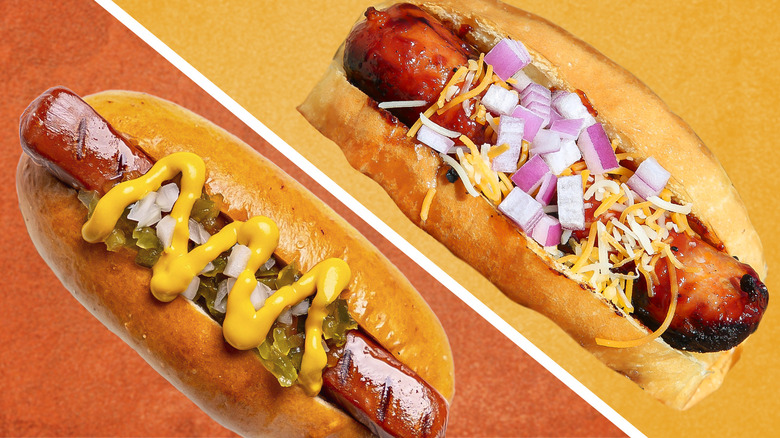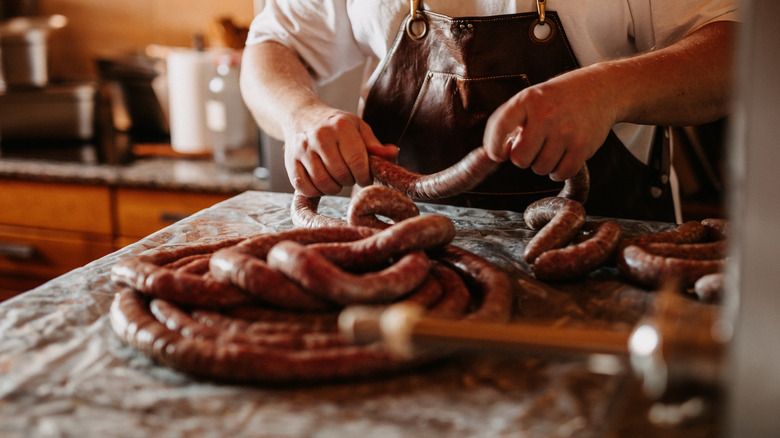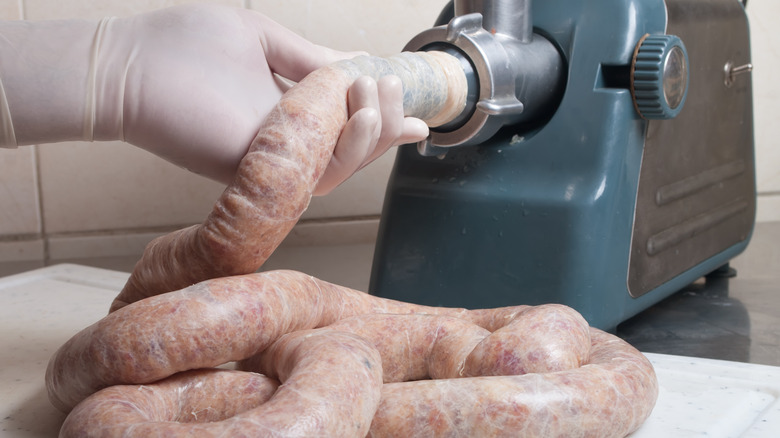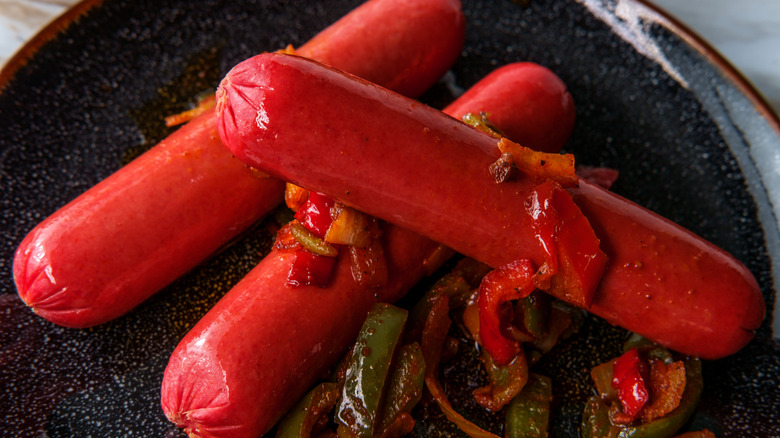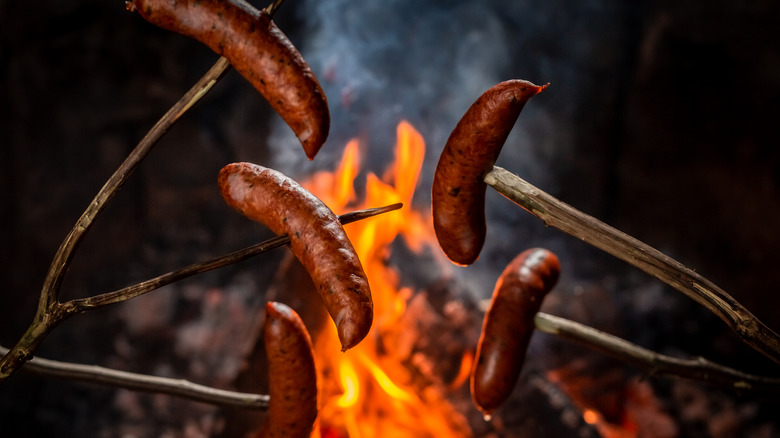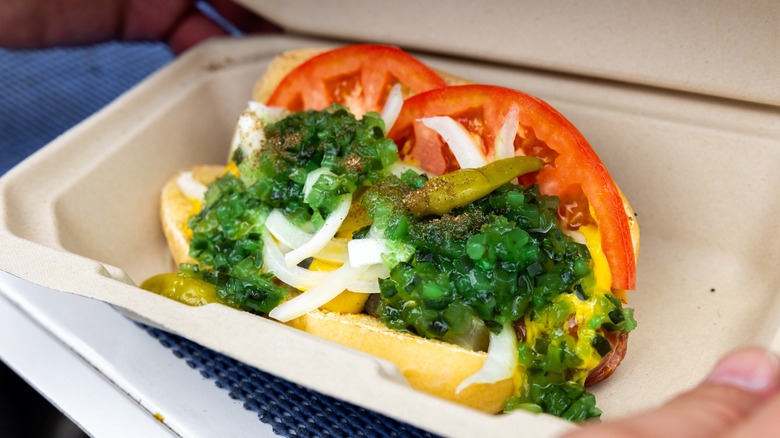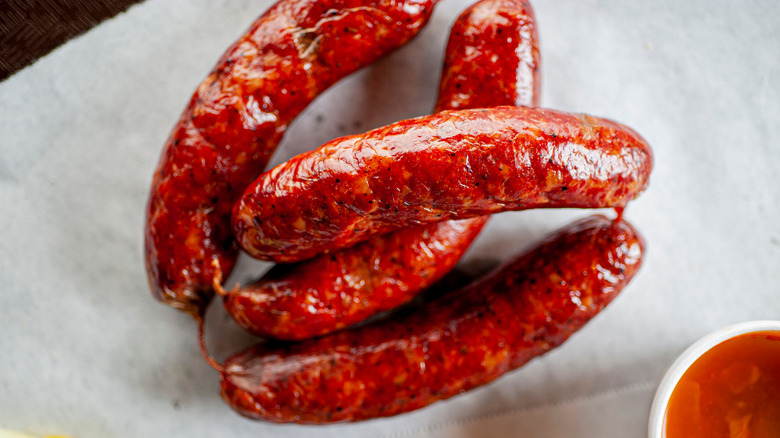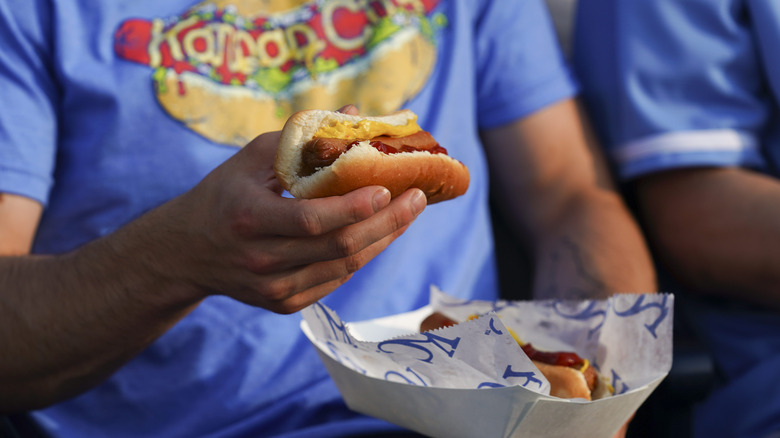Hot Dogs Vs Hot Links: Experts Explain The Difference
Glizzy, wiener, frank, Coney; no matter what you call it, a hot dog is what you're going to get — that is, unless you order a hot link. The two foods sound mighty similar, but are actually quite different. Besides being tube shaped meat products that can be made from beef and/or pork, the two sausage subcategories don't have too much in common. We, with the help of a couple experts, are here to play "spot the difference."
Mashed has spoken with two meat know-it-alls to separate the links from the dogs. Dennis Lee of The Takeout and The Party Cut is a food writer who has been recognized on the cover of Bon Appétit for his knowledge of hot dogs and hot links. In addition to picking the brain of a hot dog connoisseur, we've interviewed a professional butcher. Kyle Morse is the owner and operator of The Mayor, a small batch sausage company, and an expert in all things sausage.
Now, you've likely eaten a hot dog. You may have even cut into a hot link or two. Taste isn't all that separates these two meaty meals, though, so let's dig in to their delectable differences together.
Hot links are typically more artisanal and higher quality than hot dogs
As a general rule, the products available at a butcher shop will be of a higher quality than those packaged and massively produced in big box stores. This comes down to the artisan ability of the butcher, the freshness of the meat they acquire, and their professional attention to detail. With this being said, it's commonplace for butchers to carry their own signature hot links, but hot dogs in this capacity are a rarer find. Instead, you may find mass marketed, packaged brands similar to what you'd find in a big box store.
When Mashed spoke to The Mayor owner and butcher Kyle Morse, he explained the value of sourcing meat from your local butcher. Butchers take great pride in their work, their products usually coming from local farms. Even if the meat is not local, you're not typically going to find meat from factory farm raised animals. Instead, products made from this meat found in local specialty meat shops are going to be more ethical, healthier, and taste better.
If you do happen across hot dogs that have been made in-house by a butcher, you will get that artisan quality we see in hot links. According to Morse, each butchery will use their own signature blend of spices in their crafted hot dogs, so they would be worlds away from your store bought, packaged franks.
Hot dogs are almost always served on a bun
By all means, you are free to keep cutting up your hot dogs for the ultimate mac and cheese add-on or go low carb by skipping the bun. Most hot dog eaters do employ and encourage the use of a bun, though. The hot dog's hand-held nature has made it an instantly recognizable dish, and the use of a bun has inspired many hot dog specific loafs found scattered around the bread aisle.
Though you certainly can load a hot link onto a bun for a hot dog-esque meal, the links are typically eaten by their lonesome or as a breakfast side. No one would bat an eye if you choose to chow down on a hot link with the aid of a fork. It's a completely different story where glizzies are concerned, though. Despite it being a free country and all, eating a hot dog with anything other than your God-given hands is seen as completely un-American.
This particular distinction between hot dogs and hot links may exist due to their interchangeability, and lack thereof. Hot links can act as hot dogs, but the opposite can't easily be said. Unlike hot links, glizzies aren't really breakfast approved or satisfying all on their own.
Hot links are made differently than hot dogs
The biggest physical difference between hot dogs and hot links is how they are made. Though there are certainly similarities in the crafting processes, Kyle Morse laid out the differences quite plainly for us. "Hot links are ground once and mixed," the meat expert explained. "Hot dogs are ground several times as well as whipped and turned into a paste." This means that a hot link will have larger grains than that of a hot dog.
When you bite into a hot dog, the consistency is relatively static all the way through. A hot link, on the other hand, has small chunks of meat and fat that you can differentiate visually. While still ground, the meat of a hot link is much more evident of coming from a cut of pork or beef.
Outside of a local butcher processing the meat for a hot dog, large distributors will have machines that break down animal parts along with meat. These machines turn the material into liquid, which is then essentially poured into hot dog shaped molds. Yum.
Hot dogs always come precooked
Though it may seem taboo to some, you can actually eat a hot dog right out of the package. Is it going to be cold, slimy, and probably pretty unpleasant? That's a fair estimate, but those dogs are actually already cooked. A hot dog is actually pretty similar to luncheon meat or bologna in this way, but eating this delectable deli meat without reheating it may not be a great plan for some people. People who are pregnant or immunocompromised should heat their hot dogs whichever way they prefer to steer clear of listeriosis. Listeriosis is a bacteria found on food, and it can have serious negative effects on those susceptible.
It is possible to find packaged hot links that come precooked, and they'll likely come in a similar package as hot dogs. If you're going for the goods, though, you'll probably find them raw and ready to cook. Whether you're grilling them, using a smoker, or frying them in a pan, the center should reach a temperature of 160 F.
Hot links are often spicy
The key to a good hot link, and one of the many things that set them apart from a hot dog, is in the spices. Sausage makers use a wide variety of spices to make a flavorful hot link, and in many cases it is the maker's own signature blend. Hot links also are known to have a good amount of heat to them, making good use of cayenne pepper and paprika. Sometimes these potent spices can give the sausage a red color as well.
We asked Kyle Morse about the flavor profile of hot links and what kind of spices butchers typically use to achieve it. According to him, thyme, onion, along with cayenne are popular choices for the type of sausage. Other sources of heat can be used as well, like other peppers. "This would be similar to an andouille type of sausage, just ground up much finer," he reasoned.
Though they don't usually look like it, hot dogs do have spices in their recipe as well. A glizzy's seasonings are typically much more mild than that of a hot link, though.
Hot dogs have brand loyalty
If you've ever purchased hot dogs from a big box store, you've probably come into contact with the big wall of refrigerated hot dogs. There's typically rows upon rows of different brands and styles of hot dogs that seemingly look the same. Some shoppers may simply choose one at random or by price, but others actually do have a die-hard preference when it comes to their wieners.
Food writer and eater Dennis Lee is one of these die-hards, along with seemingly the whole of Chicago. "You cannot dress an Oscar Mayer wiener with Chicago-style toppings and expect anyone to accept this as a proper Chicago-style dog," he expressed. "Our gold standard sausage comes from a company called Vienna Beef ... if the hot dog itself isn't any good, the whole thing isn't."
Lee, and Chicago in general, are not alone in their brand loyalty. In our ranking of the best grocery store hot dog brands, Nathan's Famous Angus Beef Franks came out on top. Competitive eaters are also loyal to Nathan's, the dog being used in hot dog eating contests. As for hot links, a favored brand is not as widespread, considering most choose to purchase from their local butcher.
The way you cook a hot link really matters
Another way hot links deviate from classic hot dogs is in the way they are cooked. While you can approach the cooking of both meat products in a number of ways, the method doesn't really matter with hot dogs. "Since hot dogs are already cooked they just need to be heated up ... steaming, boiling, grilling, or frying, it just depends on what your exterior texture preferences are," Dennis Lee stated when asked if there's a "best" way to cook a hot dog. "Just don't serve a lukewarm or cold hot dog."
If you're purchasing hot links from the butcher or another specialty store, the raw sausage will cook differently with various methods. Hot links are often on BBQ platters, and the cooking of the meat has become something of an art form for many pitmasters. Grilling or smoking is typically the preferred way for these chefs. You'll also see this type of sausage fried or seared in a pan like breakfast sausage. At the behest of meat expert Kyle Morse, just steer clear of liquid smoke and instead utilize a natural smoking method for a more pleasant flavor.
Hot dogs encapsulate a wide range of similar products
Unless you regularly buy the same brand in stores, there's really no such thing as a run-of-the-mill hot dog. Every time you order a hot dog, it's a tale of a different wiener. We're not just talking about toppings and bun choices here, either, because the dog itself can be modified quite a bit in its making. This is how Dennis Lee laid it out for us: "Hot dogs can vary widely from their casings (natural, collagen-based, skinless, etc.), spice flavoring, meat grind fineness, length, that kind of thing. They can taste extraordinarily different from each other."
Taste isn't the only thing that is altered by these modifications. Texture and smell also see a change, two traits that heavily affect the perception of flavor. All those names that a hot dog goes by certainly make sense now, and a simple frank turns out to not be so simple.
So, where does that leave hot links? Hot links fall under the umbrella of sausage, and they sit somewhere adjacent to the slew of variations that people consider to be hot dogs. Simply put, a hot link is a hot link and a hot dog is a whole lot more.
Hot links have a shorter history than hot dogs
America is known as the melting pot of culture, which includes some pretty epic food. In fact, American food is pretty much just modified versions of cultural dishes that have been shared by immigrants. The hot dog, despite now being considered an all-American food, is one such dish.
The exact origin of the hot dog is up for debate, with both Frankfurt and Vienna in Germany claiming to be its birthplace. Either way, hot dogs date back to before the United States was on the map. Once Germans hit Ellis Island, though, New York City and hot dogs became a pair that has certainly stood the test of time. Now you can find homages to the food throughout the city, from hot dog stands to oversized sculptures.
Alternatively, hot links as we know them were born in the United States' Southern region well after the establishment of the U.S. We'll talk more about the Southern charm of hot links a bit later. However, the sausage variant is a relatively new product of the ancient art of sausage making.
Hot dogs have regional topping presets
We've already touched on the flavor of hot links, the herbs and spices packing a certain spiciness. Unlike a savory hot link, hot dogs get a massive amount of their taste profiles from the toppings diners load onto them. Interestingly enough, the default toppings that can be found on a frank changes depending where in the country you happen to be ordering one.
If you're a ketchup and mustard only kind of person, you've only just begun to dive into the extensive world that is hot dogs. Chicago is home of one of the most famous regional hot dog styles. You'll find their weenie loaded high with a slew of toppings, including a neon green relish. Coney Island's namesake dog is akin to a chili cheese dog with a smattering of diced onions and a drizzle of yellow mustard on top. Atlanta adds coleslaw, and a Philly classic sees a fish cake atop a dog – hey, don't knock it 'til you try it!
Our hot dog expert Dennis Lee happens to also be a Chicagoan, and spoke on the passion people have for their local, Chicago style hot dog. "You'll get people who are willing to argue for their hometown hot dog style until they're red in the face," he said. "It's sort of like sports team loyalty. Fans are wildly proud of their hot dog styles."
Hot links have roots in Southern cuisine
Hot dogs may have a deeper history and wider culture than hot links, but the latter packs a punch in the South. The artisan sausage links have roots in both Texas and New Orleans, with each locale crafting a unique, enjoyable meat product. Unlike hot dogs, the stylized differences in hot links is not in their toppings, but in the spices mixed with the meat during creation. Recipes from the two hot link homes can also result in a different textured hot link as well.
New Orleans hot links are inspired by the city's Cajun and Creole heritage, and are truly "hot" links. There's some serious heat behind a NOLA hot link, which is also referred to as "chaurice." Some brands even appear to be red in color from infused spices like cayenne and dried red peppers. When you order hot links in Louisiana, there's a good chance what you'll get is a Patton's hot sausage. If you ask any of the locals, the brand is a soul food staple and has been for generations.
The Texan hot link is not spicy in nature, but rather utilizes savory spices like thyme and garlic. Additionally, a New Orleans style hot link typically has an andouille-like texture, whereas a Texan sausage can come with a softer, malleable middle. The spread of hot links has seen new takes on their original recipes, but these Southern sausages still maintain their identity back home.
Hot dogs have made a large contribution to Americana culture
One major difference in hot links and hot dogs is distinguishable without tasting or even setting your eyes on the two sausage variations. Hot dogs have a massive presence in America and have become a major component to Americana culture. After hitting New York City, the hot dog spread quickly throughout the country as a standard American meal. And now, as glizzy connoisseur Dennis Lee puts it, "We consider hot dogs just a regular part of our daily lives."
While hot links make for a hearty breakfast, they do not have the following of the hot dog. There is a certain camaraderie centered around hot dogs in America. Lee believes this may partially come from the affordability and accessibility of a good frank. "They're typically very cheap and convenient, which makes them perfect for all income classes," he explained. "You'll see construction workers in the same line as white collar employees for the same exact order." Hot dogs also have a major presence at baseball games and at Fourth of July cookouts, two things that are undeniably American.
Hot dogs can be found on countless children's menus in America, and the love of glizzies is established at an early age. With hot dog stands and specialized restaurants in abundance in cities, the food is one thing that people all over the country seem to agree on.
Static Media owns and operates Mashed and The Takeout.
